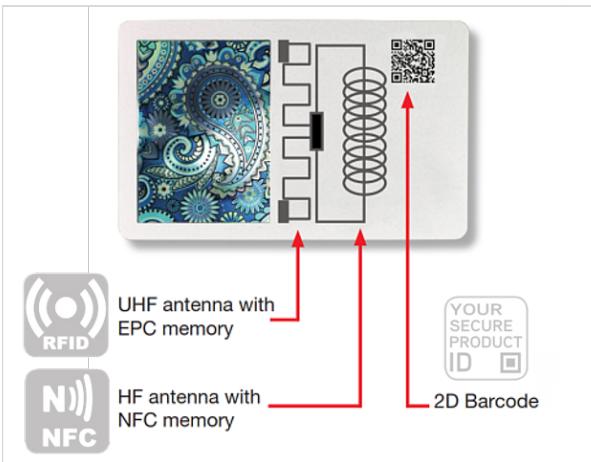2.2 Supply Chain Security Solutions to address the risk scenarios We will now provide some practical examples using the submissions we received to show how the combination of all these elements can limit some of the risks highlighted by the scenarios. The use of the submissions will also allow us to appreciate the different approaches that can be followed to ensure supply chain security as well as some innovative and potentially interesting features that contributors include to better respond to the risks presented by the scenarios. Some of these features could already be implemented in the market while for others, additional research and development may be needed.
2.2.1 Product authentication and track and trace: unique visual identity Technology submission 1 This submission focuses on the use of a machine-readable unique code and its subsequent coding, decoding and validation system. The solution is based on printing of stamps, seals or labels that are attached to the products and that are tamper evident. The authentication component of this technology is quite innovative, as it merges different elements to authenticate the product, namely a machine-readable 2D barcode (using symmetric and asymmetric cryptography), security holograms and glitter inks with unique patterns. The objective of the solution is to code information in a unique identifier that combines several layers of security measures by combining the physical characteristics of the product with a digital identity that is stored in a code that is fully customizable and adaptable to any product. The code is readable via a mobile app, enabling authorities, stakeholders and customers to read the code at any point. Coded information can be performed via several layers of security, such as private, public and encrypted. The code can be hidden in the aesthetics of the design and has high capacity to store a great amount of information. One of the most interesting aspects of this option relates to the creation of a unique visual identity of the product to be authenticated and then tracked and traced. The code provided by this solution is composed of a graphic and a physical component. The graphic code is the printed part of the solution (a bidimensional code composed of cells that can be filled with a grid of pixels) and is designed to be validated by using images acquired by most cameras. Additionally, the presence of a hologram increases the security of this code by providing a specific optically variable response to improve visual identity, with design features and a geometric description that are unique for the specific hologram cut. This is the physical part of the code. By having the graphic code and the hologram working together, the test of authenticity of the visual identity can be improved through a cross validation between the graphic code and the hologram. The random-generated geometric coordinates of the hologram can be coded in the graphic code part. After this, they are photographed and registered at the production line, linking the physical product to their digital identity. The unique random position of the hologram is almost impossible to reproduce, and its validation can be made offline. In a nutshell, the complete authentication solution can be divided into different security layers: 1) the printed-graphic code, 2) holographic Optical Variable Devices (OVD), and 3) the glitter inks; all which have a unique and irreproducible pattern. Furthermore, glitter-ink patterns unique to each code can also be used for authentication purposes and as unique product identifiers due to their physical unclonable function (PUF). Glitter inks produce a random permanent pattern when printed. It is a printing process defined as “chaotic” and guarantees a unique pattern each time it is produced. The brightness of glitter particles provides an additional mechanism to prevent the reproduction of the authentication method since each particle reflects light in a specific direction. This unique characteristic of a printed pattern with glitter inks is unclonable and irreproducible. Validation of this complex visual identity can be performed by means of an app that identifies all the parts, decodes and validates them. The decodification can also be performed through a mobile app while offline. During the validation process through the app, several elements are analysed, such as: the stamp structure and colour, the graphic code reading, the hologram features and colour shifting, the Unique Identifier (UID) registration, the brand, the producer, and the stamp activation time. The system has capabilities to be used as a track and trace (T&T) framework, either implementing one or being integrated with an external T&T. It is also possible to integrate blockchain technology.
26











